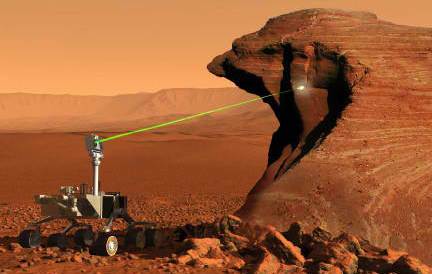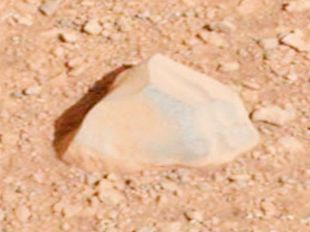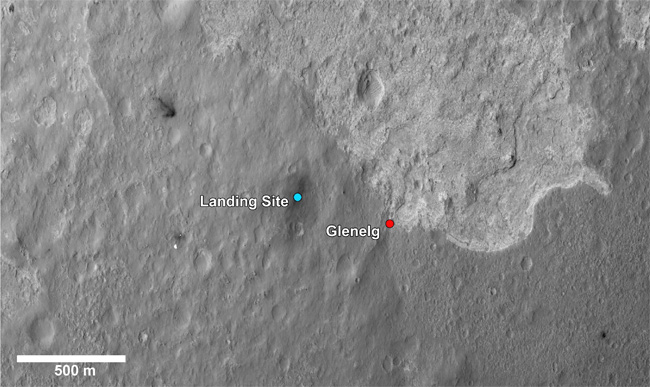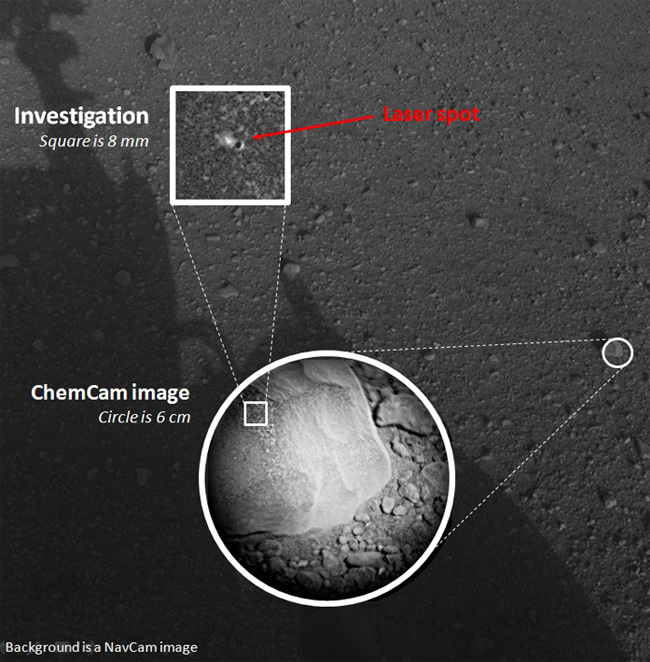Curiosity ready to budge, laser tested tonight
Among other equipment, the Curiosity rover is equipped with a unique Chemistry and Camera (ChemCam) tool, a laser for spraying rock from the surface and a camera for remotely studying the fumes. Thus, the robot can study the chemical composition of the rock on vertical slopes, as well as investigate hard-to-reach samples in pits and on elevations. There are many such places in the Gale crater.
On the night from Saturday to Sunday, Curiosity conducted the first test of a laser gun . For the first time in history, mankind used a laser of such power on other planets.

')
“Stone N165 looks like an ordinary Martian stone, about seven centimeters in size. It is located at a distance of three meters. We intend to shoot at him beams of energy 14 millijoules, 30 times in 10 seconds. This will not only test our system well, but it will also be pretty cool, ”said Roger Wiens yesterday, chief tester for the ChemCam instrument at the Los Alamos National Laboratory.
NASA published a photo of a stone that they were going to spray.

The landing of Curiosity on Mars took place on August 6, early in the morning Moscow time. Since then, the rover carried out a four-day software upgrade , took dozens of photos of the surroundings, and conducted a self-test of various devices. Now he is ready to try to budge.
The target for the first hike is the Glenelg point 400 meters east-southeast of the current location of Curiosity. This is an interesting place in geological terms. There, judging by satellite images, breeds of three types converge. We chose a palindrome as the name, because the rover must pass this place twice: on the way there and back.

If everything goes well, the rover will take a long-distance route to the foot of Mount Sharp - a unique mountain in the heart of the Gale crater. There he will try to climb a little bit on the mountain and begin to conduct basic experiments.

The drop-shaped mountain 5.5 km high from the bottom of the crater is formed by a shock wave and may contain rocks from the depths of the planet. She became the reason why Curiosity was sent to the crater of Gale.

NASA engineers are now developing step-by-step instructions for moving Curiosity 400 meters to a predetermined point, because GPS does not work on Mars and it is impossible to simply transfer coordinates to the robot.
PS Interesting fact: since the Martian day is about 40 minutes longer than the earthly days, the rover control team starts 40 minutes later every working day than the previous one : in this “Martian time” mode, the control center will work for the next two years for which the Curiosity mission is designed .
UPD 20.08. The laser test was successful . The square area in the photograph shows the pixel difference before and after the laser shot. A part of the stone's surface was turned into an ionized bright plasma with the help of 30 pulses, each with a duration of 5 ns and an energy of more than a megawatt. Photographs of evaporation taken with a telescope were analyzed by three spectrometers. The devices recorded radiation at 6144 frequencies in ultraviolet, visible and infrared light. The performance of the spectrometers (signal-to-noise ratio) was even better than during tests on Earth.

On the night from Saturday to Sunday, Curiosity conducted the first test of a laser gun . For the first time in history, mankind used a laser of such power on other planets.

')
“Stone N165 looks like an ordinary Martian stone, about seven centimeters in size. It is located at a distance of three meters. We intend to shoot at him beams of energy 14 millijoules, 30 times in 10 seconds. This will not only test our system well, but it will also be pretty cool, ”said Roger Wiens yesterday, chief tester for the ChemCam instrument at the Los Alamos National Laboratory.
NASA published a photo of a stone that they were going to spray.

The landing of Curiosity on Mars took place on August 6, early in the morning Moscow time. Since then, the rover carried out a four-day software upgrade , took dozens of photos of the surroundings, and conducted a self-test of various devices. Now he is ready to try to budge.
The target for the first hike is the Glenelg point 400 meters east-southeast of the current location of Curiosity. This is an interesting place in geological terms. There, judging by satellite images, breeds of three types converge. We chose a palindrome as the name, because the rover must pass this place twice: on the way there and back.

If everything goes well, the rover will take a long-distance route to the foot of Mount Sharp - a unique mountain in the heart of the Gale crater. There he will try to climb a little bit on the mountain and begin to conduct basic experiments.

The drop-shaped mountain 5.5 km high from the bottom of the crater is formed by a shock wave and may contain rocks from the depths of the planet. She became the reason why Curiosity was sent to the crater of Gale.

NASA engineers are now developing step-by-step instructions for moving Curiosity 400 meters to a predetermined point, because GPS does not work on Mars and it is impossible to simply transfer coordinates to the robot.
PS Interesting fact: since the Martian day is about 40 minutes longer than the earthly days, the rover control team starts 40 minutes later every working day than the previous one : in this “Martian time” mode, the control center will work for the next two years for which the Curiosity mission is designed .
UPD 20.08. The laser test was successful . The square area in the photograph shows the pixel difference before and after the laser shot. A part of the stone's surface was turned into an ionized bright plasma with the help of 30 pulses, each with a duration of 5 ns and an energy of more than a megawatt. Photographs of evaporation taken with a telescope were analyzed by three spectrometers. The devices recorded radiation at 6144 frequencies in ultraviolet, visible and infrared light. The performance of the spectrometers (signal-to-noise ratio) was even better than during tests on Earth.

Source: https://habr.com/ru/post/149831/
All Articles